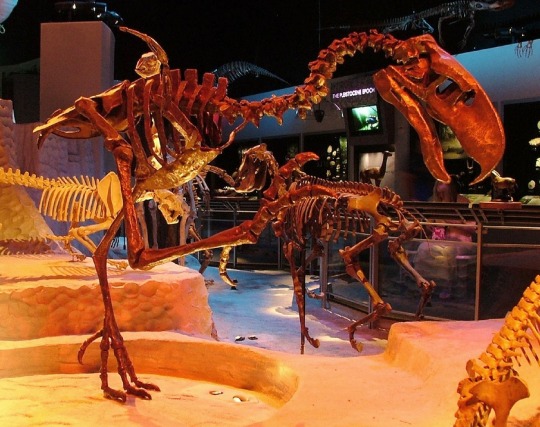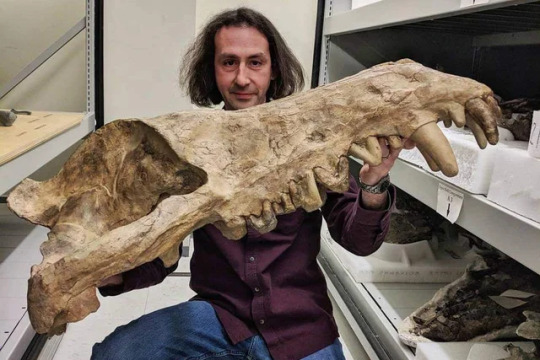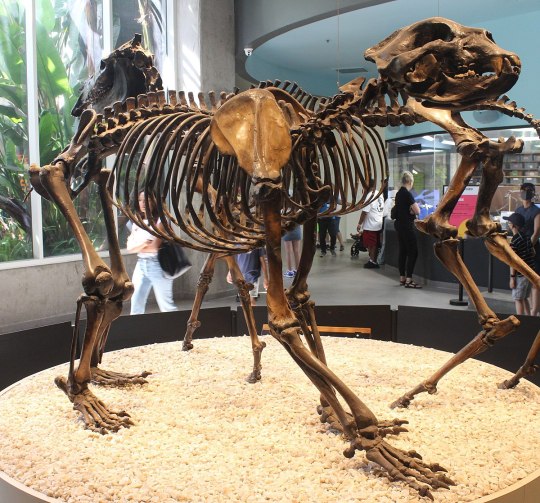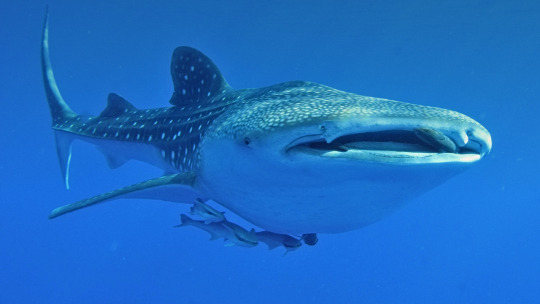#Paleoweek
Text
Animal of the Day!
Titanis (Titanis walleri)

(Photo from Florida Museum of Natural History)
Conservation Status- Extinct
Habitat- North America
Estimated Size (Weight/Length)- 150 kg; 2 m tall
Diet- Mammals
Time Period- Pliocene; Early Pleistocene
Cool Facts- Titanis was one of the larger terror birds that stalked the plains of North America for thousands of years. Incapable of flight, Titanis most likely relied on its long legs to outrun its prey. While a skull has never been found, it is assumed that Titanis had the massive, ax-like beak other terror birds of the time period had, leading to interpretations of what its complete skeleton may look like. Due to having excellent movement in their neck, it is believed that Titanis would chase down its prey and batter the animal to death with its massive beak. Titanis most likely went extinct due to competition from new predators, especially bears and big cats.
Rating- 11/10 (Could outrun a horse.)
#Animal of the day#Animals#Birds#Terror bird#Friday#January 13#Titanis#biology#science#conservation#the more you know#Paleoweek#Paleolithic#Prehistoric#Megafauna#Extinct animals#Paleontology
592 notes
·
View notes
Text
Animal of the Day!
Andrewsarchus (Andrewsarchus mongoliensis)

(Photo from American Museum of Natural History)
Conservation Status- Extinct
Habitat- Mongolia
Estimated Size (Weight/Length)- 1 tonne; 5 m
Diet- Large mammals; Carrion
Time Period- Late Eocene
Cool Facts- The Andrewsarchus may be one of the most mysterious animals of the late Eocene. With only one skull found in 1923, it has been estimated that Andrewsarchus is the largest terrestrial carnivore in history. Being the size of a horse and as fast as one, this hoofed predator could take down the other megafauna that roamed ancient Mongolia with ease. Andrewsarchus sports enlarged secondary canines that most likely would have been deadly with a crushing bite force thanks to its elongated snout. Comparing Andrewsarchus to other mesonychids, paleontologists have assumed that they had relatively short legs for their long body and massive head.
Rating- 12/10 (Just wait until we find a complete one.)
#Animal of the day#Animals#Mammals#Mesonychids#Artiodactyls#Thursday#January 12#Andrewsarchus#biology#science#conservation#the more you know#Paleoweek#Paleolithic#Prehistoric#Megafauna#Extinct Animals#Paleontology
304 notes
·
View notes
Text
Animal of the Day!
Steppe Mammoth (Mammuthus trogontherii)

(Photo from The Azov Museum)
Conservation Status- Extinct
Habitat- Northern Europe; Northern Asia
Estimated Size (Weight/Length)- 14 tonnes; 4.5 m tall
Diet- Leaves; Grasses; Shrubs
Time Period- Pleistocene
Cool Facts- The steppe mammoth was the largest mammoth of the Pleistocene, although not the largest elephant of all time. Being the ancestor to the wooly mammoth, the steppe mammoth had massive tusks that could reach 5 meters long on the bulls. Steppe mammoths most likely played a similar role to African elephants today. They would push down trees and create rivers with their tusks, playing a major part in the ecosystem. These mammoths most likely lived in small herds although their general ecology is lesser known due to so few skeletons being found. The steppe mammoth most likely went extinct due to a combination of climate change and overhunting from humans.
Rating- 13/10 (Ice Age baby 2: Electric boogaloo.)
#Animal of the day#Animals#Mammals#Mammoth#Elephant#Saturday#January 14#Steppe Mammoth#biology#science#conservation#the more you know#Paleoweek#Paleolithic#Prehistoric#Megafauna#Extinct animals#Paleontology
307 notes
·
View notes
Text
Animal of the Day!
Paraceratherium (Paraceratherium transouralicum)

(Photo from Izi Travel)
Conservation Status- Extinct
Habitat- Europe; Asia
Estimated Size (Weight/Length)- 20 tonnes; 7 m; 5 m tall
Diet- Leaves; Shrubs
Time Period- Oligocene
Cool Facts- The Paraceratherium is one of the largest land mammals in existence, but due to incomplete skeletons the confirmed size is unknown. This massive, hornless rhino was more similar to a giraffe than its modern ancestors. Comparing Paraceratherium to elephants, paleontologists believe that they live in small family groups. It is also believed that they were migratory due to the scarcity of food in their homerange. The much smaller predators of the Oligocene stood no chance in taking adults down. However, calves were sometimes targeted by Astorgosuchus, a 10 meter crocodile, due to evidence of bite marks on bones. Paraceratherium most likely went extinct due to climate change and new competition from gomphotheres, elephant-like giants.
Rating- 13/10 (Walking with Beasts anyone?)
#Animal of the day#Animals#Monday#January 9#Paraceratherium#biology#science#conservation#the more you know#Paleoweek#Paleolithic#Prehistoric#Megafauna#Mammals#Extinct animals#Paleontology
231 notes
·
View notes
Text
Animal of the Day!
Castoroides (Castoroides dilophidus)

(Photo from Canadian Museum of Nature)
Conservation Status- Extinct
Habitat- Southeastern United States
Estimated Size (Weight/Length)- 120 kg; 2 m
Diet- Leaves; Bark
Time Period- Pleistocene
Cool Facts- The Castoroides is the ancestor to beavers that still roam the wilds today. Considered the largest beaver to ever exist, they are thought to have a semi aquatic lifestyle similar to modern beavers, and yet they lacked a paddle-like tail. Their massive 15 cm long teeth would tear through wetland trees and provide defense against megafauna predators. It is unknown whether or not Castoroides built dams based on their living ancestors, however paleontologists believe this may have been the case due to finding a massive, ancient beaver lodge alongside several Castoroides remains in Ohio. The Castoroides went extinct at the beginning of the Holocene, either from climate change or overhunting from migrating humans.
Rating- 12/10 (That’s one big Bucky.)
#Animal of the day#Animals#Mammals#Beavers#Sunday#January 8#Castoroides#biology#science#conservation#the more you know#Paleoweek#Paleolithic#Prehistoric#Megafauna#Extinct animals#Paleontology
204 notes
·
View notes
Text
Animal of the Day!
Arctodus (Arctodus simus)

(Photo from La Brea Tar Pits)
Conservation Status- Extinct
Habitat- North America
Estimated Size (Weight/Length)- 950 kg; 3 m
Diet- Large mammals; Leaves; Fruits; Carrion
Time Period- Late Pleistocene
Cool Facts- Being possibly the largest terrestrial carnivore in North America, Arctodus was an absolutely massive bear that would put a grizzly to shame. Preferring open woodland, these massive bears are comparable to a long legged, short snouted grizzly as tall as an average man. Able to eat almost anything, the flexible range of the Arctodus speaks for itself. Arctodus was most likely solitary and hibernated through the winter, due to multiple skeletons being found in caves. Surprisingly, Arctodus was around at the same time modern grizzly and black bears roamed. Being much larger, Arctodus was seemingly a better competitor. At least, that is until climate change and humans killed off their main food source and resulted in the large bears going extinct.
Rating- 11/10 (Not your average Yogi.)
#Animal of the day#Animals#Mammals#Bears#Tuesday#January 10#Arctodus#biology#science#conservation#the more you know#Short-faced bear#Paleoweek#Paleolithic#Prehistoric#Megafauna#Extinct animals#Paleontology
227 notes
·
View notes
Text
Animal of the Day!
Uintatherium (Uintatherium anceps)

(Photo from Tokyo National Museum of Nature and Science)
Conservation Status- Extinct
Habitat- North America
Estimated Size (Weight/Length)- 2 tonnes; 4 m
Diet- Aquatic plants; Shrubs
Time Period- Eocene
Cool Facts- With the body of a rhino, the head of a hippo, and the tusks of a boar, the Uintatherium is one of the largest land animals to ever exist in North America. The teeth were larger on the male and were most likely used as a form of sexual selection or fighting for mates. Otherwise, they were used to pull plants out from the water as it is suspected Uintatherium could walk along river beds like modern hippos. Despite all the evidence pointing against it, when first discovered Uintatherium was assumed to be a carnivore due to its ferocious teeth.
Rating- 13/10 (Despite the teeth, it’s not a smilodon.)
#Animal of the day#Animals#Mammals#Wednesday#January 11#Uintatherium#biology#science#conservation#the more you know#Paleoweek#Paleolithic#Prehistoric#Megafauna#Extinct animals#Paleontology
123 notes
·
View notes
Text
Thank You!
When I started this blog I never expected it to grow as much as it has. So thank you. Seriously, thank you so much. 3,000 followers is pretty crazy. I hope that all of you will continue to learn with me about the wonderful creatures that roam our wilds. In celebration, starting tomorrow Paleoweek begins. I picked out seven amazing creatures from the Paleocene to the Pleistocene and have dedicated my posts to them! Once again, thank you. I quite literally couldn't have done it without you.
#Animal of the day#Animals#3000 followers#thank you#Paleoweek#Paleolithic#Prehistoric#Megafauna#Extinct animals
26 notes
·
View notes
Note
request for a whale shark
Hi Anon! Sorry for getting back to you so late, I just got back from a trip to California. I can absolutely do a whale shark! Expect a post on them right after Paleoweek!

(Photo from PBS)
36 notes
·
View notes